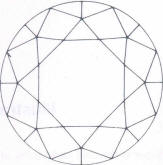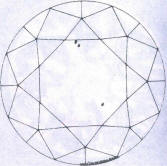Terms giving detailed definitions of clarity are very useful to the expert, but it has been shown in practice that a representation in the form of photographs and diagrams showing typical inclusions are of valuable help as they enable one to compare the stone to be graded with the illustration showing similar inclusions and thus give the possibility of reliably grading the stone.
No diamonds is exactly like another one, and yet each clarity grade contains certain characteristics.
The following illustrations represent the characteristics of each clarity grade an should be a useful aid for the grader - especially the beginner - to find the correct classification.
All illustrations are shown at 10 x magnification. The sketched representation of the photographs show again clearly the position of the inclusion.
VVS
 |
 |
| Fig 49 A pinpoint inclusion under the table | |
 |
 |
| Fig 50 A tiny cleavage crack at the girdle, penetrating into a crown main facet | |
 |
 |
| Fig 51 A pinpoint inclusion under a girdle facet | |
 |
 |
| Fig 52 A cloud under the table, a crack in a crown main facet | |
 |
 |
| Fig 53 Three tiny crystals under the table | |
 |
 |
| Fig 54 A tiny cloud in a crown main facet | |
 |
 |
| Fig 55 A crack-line indentation mark in pavilion facet edge seen through the crown | |
 |
 |
| Fig 56 As Fig 55. seen through pavilion | |
 |
 |
| Fig 57 Two little crystals under the table | |
 |
 |
| Fig 58 Three pinpoint crystals under the table, crack like fringes | |
 |
 |
| Fig59 A few, very small light inclusions in the crown | |
 |
 |
| Fig 60 Small crack in the crown main facet | |
 |
 |
| Fig61 Three very small light crystals under the table | |
 |
 |
| Fig 62 Two tiny cracks in the girdle, a pinpoint inclusion under the table | |
 |
 |
| Fig 63 A minute light crystal under the table, crack-like fringes | |
 |
 |
| Fig 64 A light cloud under the table | |
 |
 |
| Fig 65 A small crack in a table facet | |
 |
 |
| Fig 66 Crack-like fringes in the girdle | |
| Definition of Clarity Grades | Illustrations VS |